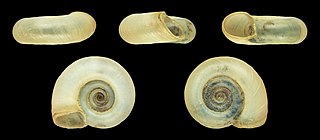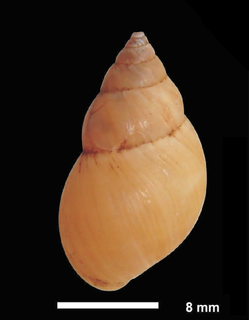Related Research Articles

Limax maximus, known by the common names great grey slug and leopard slug, is a species of slug in the family Limacidae, the keeled slugs. It is among the largest keeled slugs, Limax cinereoniger being the largest.

Ancylini is a tribe of small, freshwater, air-breathing limpets, aquatic pulmonate gastropod mollusks in the family Planorbidae, the ram's horn snails and their allies. This tribe used to be treated as a family; the current taxonomic placement within Planorbidae is according to the taxonomy of the Gastropoda.

Biomphalaria glabrata is a species of air-breathing freshwater snail, an aquatic pulmonate gastropod mollusk in the family Planorbidae, the ram's horn snails.

Hygrophila is a taxonomic superorder of air-breathing freshwater snails, aquatic pulmonate gastropod mollusks within the clade Panpulmonata.

Biomphalaria tenagophila is a species of air-breathing freshwater snail, an aquatic pulmonate gastropod mollusk in the family Planorbidae, the ram's horn snails.
Biomphalaria andecola is a species of air-breathing freshwater snail, an aquatic pulmonate gastropod mollusk in the family Planorbidae, the ram's horn snails.

Biomphalaria peregrina is a species of air-breathing freshwater snail, an aquatic pulmonate gastropod mollusk in the family Planorbidae, the ram's horn snails.

Bulimulus tenuissimus is a species of tropical air-breathing land snail, a pulmonate gastropod mollusk in the subfamily Bulimulinae.
Uncancylus is a genus of small, freshwater, air-breathing limpets, aquatic pulmonate gastropod molluscs in the family Planorbidae, the ram's horn snails and their allies.
Uncancylus concentricus is a species of small, freshwater, air-breathing limpet, an aquatic pulmonate gastropod mollusc in the family Planorbidae, the ram's horn snails and their allies.
Anisancylus is a genus of small, freshwater, air-breathing limpets, aquatic pulmonate gastropod molluscs in the family Planorbidae, the ram's horn snails and their allies.
Anisancylus dutrae is a species of small, freshwater, air-breathing limpet, an aquatic pulmonate gastropod mollusc in the family Planorbidae, the ram's horn snails and their allies.
Anisancylus obliquus is a species of small, freshwater, air-breathing limpet, an aquatic pulmonate gastropod mollusc in the family Planorbidae, the ram's horn snails and their allies.
Uncancylus foncki is a species of small, freshwater, air-breathing limpet, an aquatic pulmonate gastropod mollusc in the family Planorbidae, the ram's horn snails and their allies.
Burnupia ingae is a species of minute freshwater snail or limpet, an aquatic gastropod mollusc or micromollusk that is traditionally placed in the family Planorbidae, the ram's horn snails and their allies.
Hebetancylus is a genus of small, freshwater, air-breathing limpets, aquatic pulmonate gastropod molluscs in the family Planorbidae, the ram's horn snails and their allies.
Hebetancylus moricandi is a species of small, freshwater, air-breathing limpet, an aquatic pulmonate gastropod mollusc in the family Planorbidae, the ram's horn snails and their allies.
Laevapex is a genus of small, freshwater, air-breathing limpets, aquatic pulmonate gastropod molluscs in the family Planorbidae, the ram's horn snails and their allies.
References
- ↑ Roskov Y.; Kunze T.; Orrell T.; Abucay L.; Paglinawan L.; Culham A.; Bailly N.; Kirk P.; Bourgoin T.; Baillargeon G.; Decock W.; De Wever A.; Didžiulis V. (eds.). "Laevapex vazi Santos, 1989". Species 2000 & ITIS Catalogue of Life, 2014 Annual Checklist. Species 2000: Naturalis, Leiden, the Netherlands. Retrieved 4 July 2014.
- 1 2 dos Santos; S. B. (1989). "On the morphology of Laevapex vazi n. sp. from Brazil (Molluca: Pulmonata: Basommatophora: Ancylidae)" (PDF). Memórias do Instituto Oswaldo Cruz. 84 (supl. IV): 467–473. doi: 10.1590/s0074-02761989000800082 .
- 1 2 3 dos Santos; S. B. (2003). "Estado atual do conhecimento dos ancilídeos na América do Sul (Mollusca: Gastropoda: Pulmonata: Basommatophora)" [Current state of knowledge of ancylids in South America (Mollusca: Gastropoda: Pulmonata: Basommatophora)](PDF). Revista de Biología Tropical (in Portuguese). Redalyc. 51 (3): 191–223. Retrieved 22 June 2014.